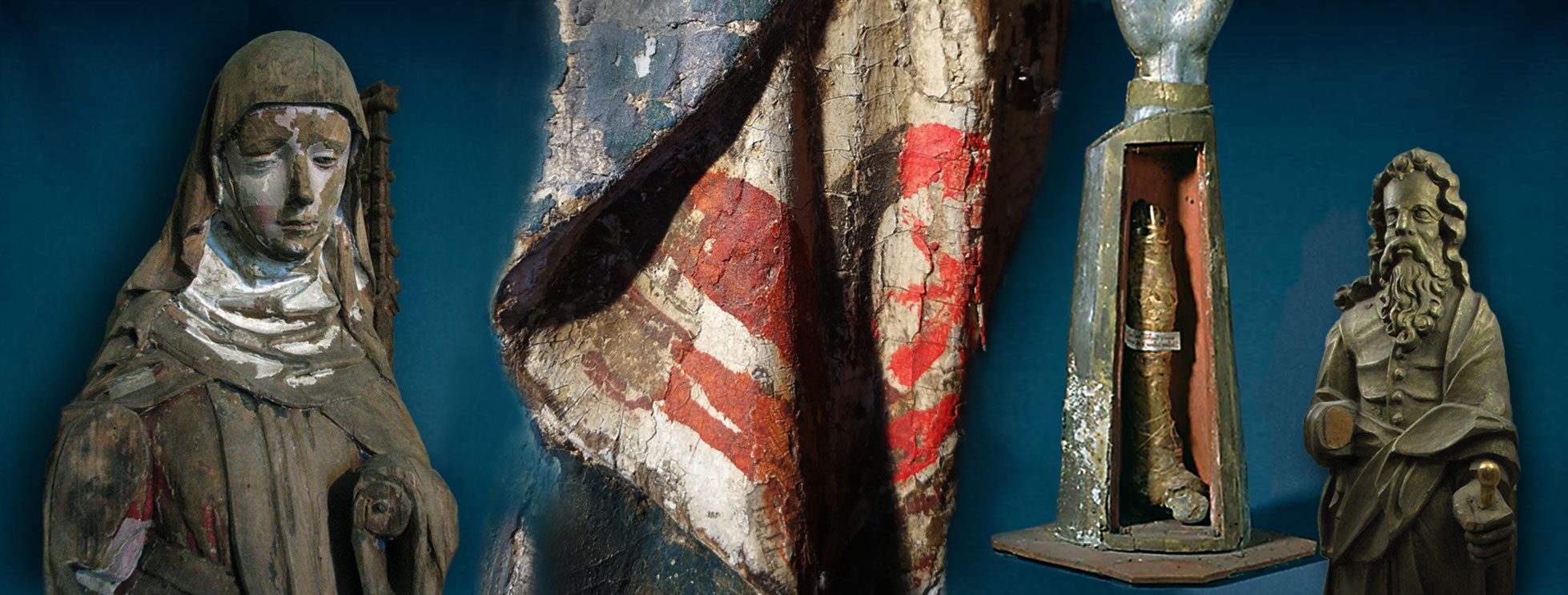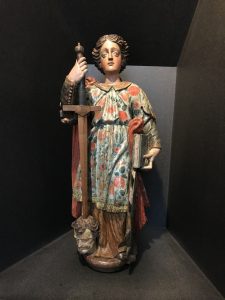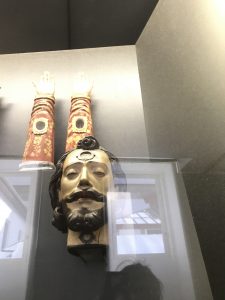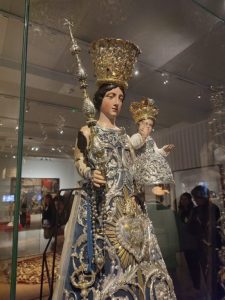
Kulkueveistos Leuvenin Pyhän Jaakobin kirkosta. Moved / M Leuven. Puku: Joseph de Backer 1840-1860. Kuva: Katri Vuola
Museo M Leuven ylläpitää Belgian Flanderin aluehallinnon tuella keskiajan ja renessanssin tutkimuksen ARDS-verkostoa. Brysselin naapurikaupungissa Leuvenissa sijaitseva museo järjestää vuosittain tämän verkoston puitteissa kansainvälisen konferenssin. Vuoden 2022 lopulla järjestetyn yhdeksännen konferenssin The Art of Devotion: The Agency Sculpture teema oli nimensä mukaisesti veistosten toimijuus hartaudellisessa kontekstissa. Osallistuin konferenssiin viitisenkymmenen muun alan asiantuntijan kanssa.
Nimensä verkosto on lainannut brysseliläiseltä kuvanveistäjä Willem Ardsilta (n.1415–1453), jonka tuotantoon kuluvat muun muassa Leuvenin raatihuoneen veistokset. ARDSin tavoitteena on alueen kuvanveistoperinteen dokumentoiminen ja asiantuntijuuden kehittäminen. Lisäksi ARDS järjestää tieteellisiä, mutta myös suurelle yleisölle suunnattuja tapahtumia ja näyttelyitä. Toiminnan avulla pyritään edistämään läntisen Euroopan keskiaikaisen ja varhaismodernin ajan taiteen tutkimusta ja tunnettuutta. Museo on muun muassa tuottanut Leuvenin vasta restauroituun Pyhän Pietarin kirkkoon (Sint-Pieterskerk) yhdistetyn todellisuuden teknologian avulla kokemuksellisen näyttelyn, johon sisältyy muun muassa Leuveniin asettuneen Dieric Boutsin (n. 1410– 1475) Viimeinen ehtoollinen ja Erasmuksen marttyyrikuolema -aiheisten teosten esittely.
Konferenssiesitelmien aiheet liittyivät veistosten toimijuuteen eli niihin moniin muotoihin ja konteksteihin, jossa veistokset toimivat vuorovaikutuksessa ihmisen kanssa. Toimijuus nivoutuu yleensä kiinteästi myös teosten aineelliseen olemiseen, erityisesti niiden aistittavaan muotoon, väritykseen ja materiaaleihin.
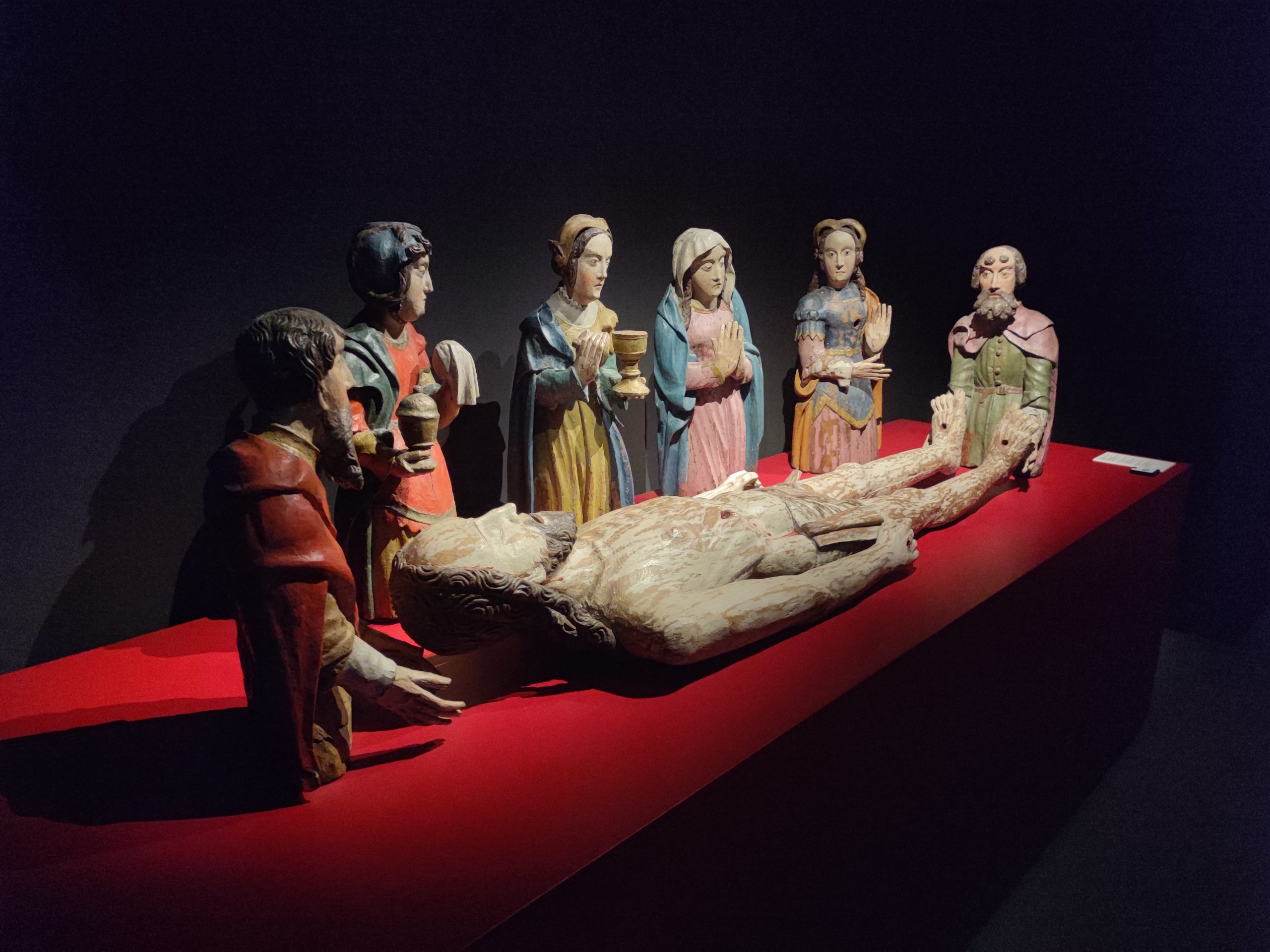
Kristuksen hautaaminen -veistosryhmä Leuvenin Pyhän Jaakobin kirkosta, 1500–1525. Moved / M Leuven. Kuva: Katri Vuola
Achenin Suermondt-Ludwig-Museumin kuraattori Dagmar Preising loi esityksessään katsauksen veistoksiin, joiden pää tai jäsenet on tehty liikuteltaviksi, sekä pyhimyslegendoihin sisältyviin ihmekertomuksiin ja kertomusten kuvituksiin, joissa esiintyy puhuvia ja liikkuvia veistoksia. Skotlannin St. Andrewsin yliopistosta saapuneen Andrew Hornin aiheena olivat italialaiset ristintien pysähdyspaikkoihin liittyvät asetelmat: näitä ovat muun muassa Kristuksen sureminen ja Kristuksen hautaaminen. Nämä asetelmat, jotka usein koostuvat luonnollista kokoa olevista maalatuista figuureista, osallistavat katsojaa Kristuksen kärsimyksen ja hänen seuraajiensa surun ruumiilliseen kokemiseen. Asetelmat liittyvät pääsiäisajan tapahtumien draamalliseen esittämiseen, mutta pysyvästi kirkkotilaan tai esimerkiksi kaupunkitilaan ”rakennettuina” ne toimivat koko kirkkovuoden hartauden kohteina.
Konferenssin muut esitelmät käsittelivät muun muassa Mechelenin jesuiittakirkon arkkitehtuurin ja kuvaohjelman suhdetta kirkon pääalttarille asetettuun pyhäinjäännökseen, sekä 1500-1600-lukujen hautamuistomerkkien merkitystä vainajan muistamisen paikkoina ja pelastuksen edistäjinä. Konferenssin aikarajaus siis jousti barokin suuntaan. Tämä jousto mahdollisti vielä useammalle tutkimusuransa alkuvaiheessa oleville jatko-opiskelijoille foorumin tuoda tutkimustaan esiin. Edellä mainittujen aiheiden lisäksi heidän esitelmänsä käsittelivät muun muassa ihmeitä tekevien keskiaikaisten ja renessanssin ajan veistosten kopioita.
Key note -puhujaksi kutsuttu Ralph de Koninck toi yhdessä Lise Konstantin kanssa kiinnostavasti esiin, miten reformaationajan teksteissä Neitsyt Maria -veistoksiin viitattiin ”kauniina nukkeina” (kermessen poppen), joiden rituaalinen käyttö vertautui leikkimiseen. Tästä kiinnostavaksi visuaaliseksi esimerkiksi esitelmöitsijät nostivat Pieter Bruegel vanhemman (1525/1530–1569) monitasoisen Lasten leikit (1560) teoksen ja sen vasempaan alareunaan sijoittuvan yksityiskohdan, jossa pienen tytön leluvalikoimaan on maalattu (Jeesuksen) kehto ja pyhimysveistoksen kaltainen nukke. Bruegelin maalauksiinsa usein sisällyttämät viitteet 1500-luvun uskonsotien tuomasta rauhattomuuden ajasta liittää leikkimaalauksen ikonoklastiseen kontekstiin.
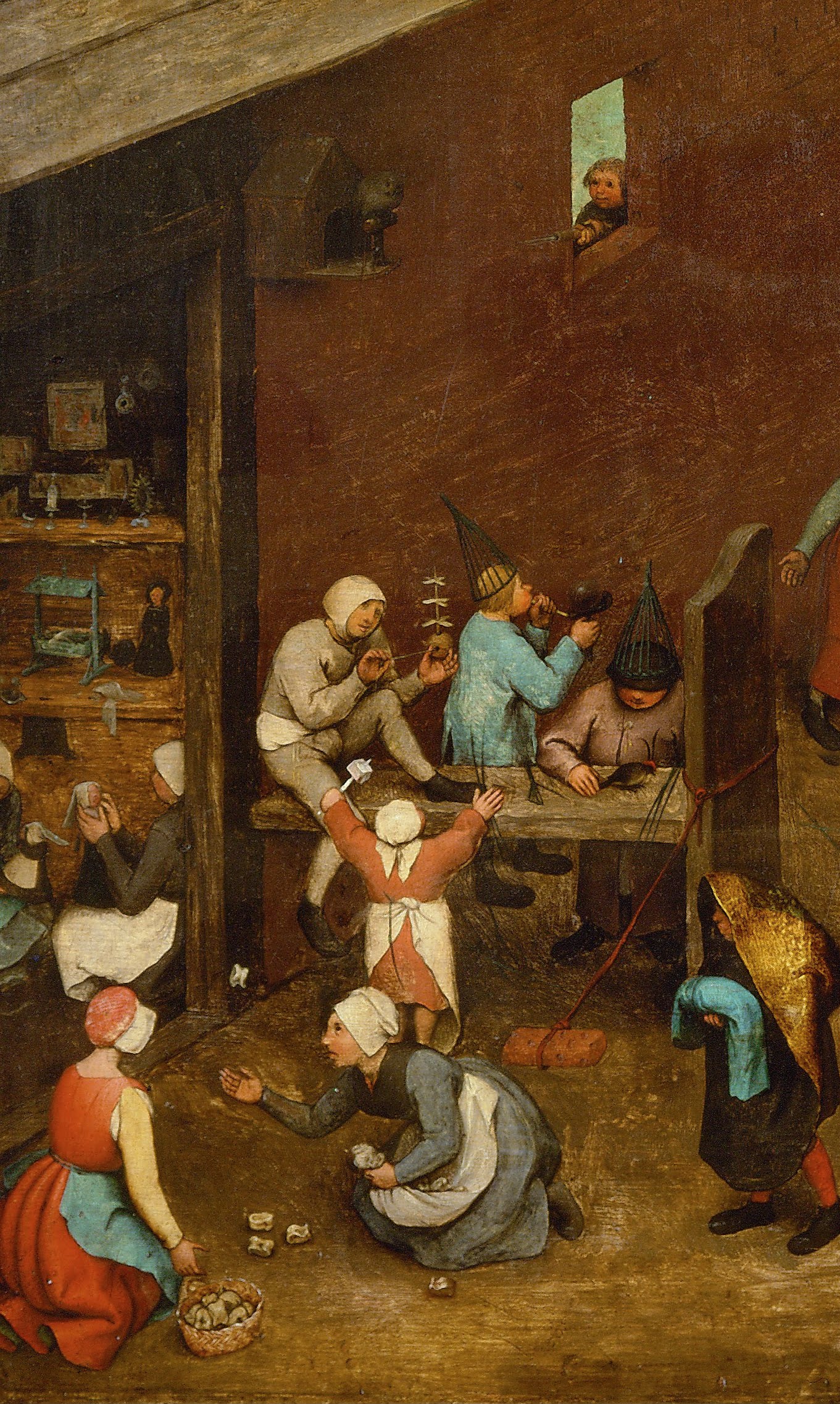
Yksityiskohta maalauksesta Lasten leikit. Pieter Bruegel vanhempi. 1560. Öljy levylle. 118 cm × 161 cm (46 in × 63 in). Kunsthistorisches Museum, Vienna. Kuva: Wikimedia Commons
Konferenssin yhteydessä tutustuimme Leuvenin ja Brabantin alueen vanhaan taiteeseen. M Leuven –museon vanhan eurooppalaisen taiteen kokoelman intendentti Marjan Debaene esitteli hiljattain museoon näytteille asetettuja uushankintoja. Näyttelykuraattori Ko Goubert puolestaan esitteli kokoelmaesineistä koostettua Moved-näyttelyä. Veistosten liikkumisen ja liikuttamisen teemoihin liittyen näyttelyssä tuotiin esille veistosten, relikvaarioiden, viirien ja asujen merkitystä katolisen kirkon kulkueissa eri aikoina.
Moved-näyttelyn yksinkertainen ja selkeä esillepano sekä hyvä valaistus korostivat esineiden materiaalisuutta ja mahdollistivat esineiden tarkastelun läheltä. Monet esineistä vaikuttivat enemminkin restauroiduilta kuin konservoiduilta: osa esineistä onkin edelleen juhlapyhinä Leuvenin seurakuntien prosessiokäytössä. Kuraattori toi esiin muutamia kiinnostavia yksityiskohtia: esimerkiksi näyttävään hopeiseen relikvaarioristiin oli kiinnitetty timantein koristeltuja korvakoruja ja jopa sukkanauhojen pidikkeitä.
Museossa järjestettiin heti ARDSin jälkeen CODART-verkoston yksipäiväinen konferenssi, joka liittyi Leuvenin museon ja Louvren taidemuseon kanssa yhteistyössä toteutettuun upeaan ja ainutlaatuiseen näyttelyyn Alabaster – European Sculpture from the Middle Ages to the Baroque.
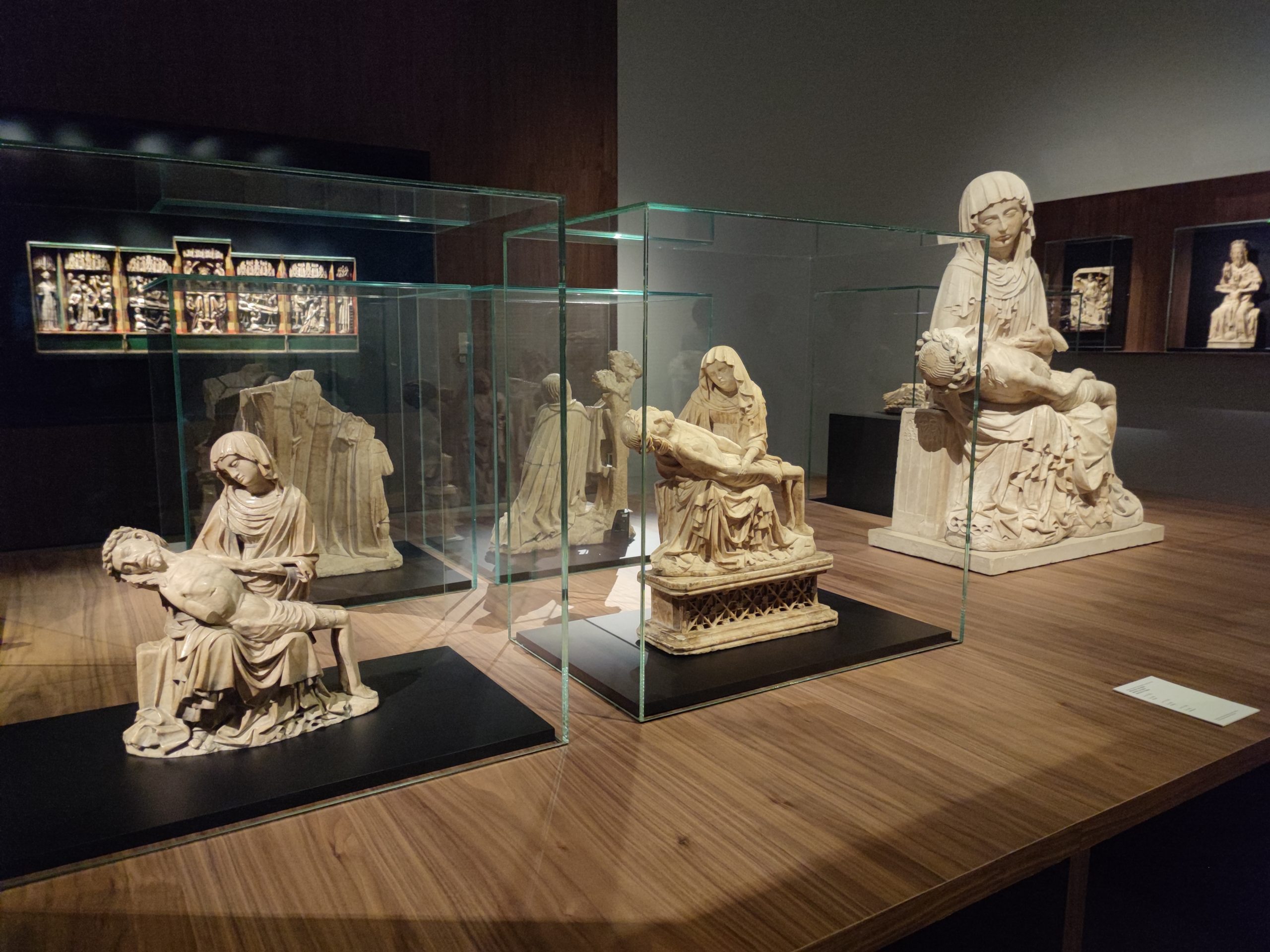
Näkymä näyttelystä Alabaster – European Sculpture from the Middle Ages to the Baroque. M Leuven. Kuva: Katri Vuola
Katri Vuola
